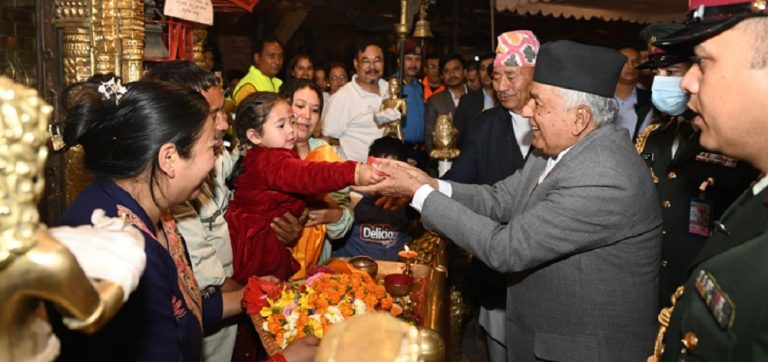President Ramchandra Paudel visited the historic Seto Machchindranath chariot at Asan on Saturday evening to perform traditional prayers. The occasion marked Chaitra Shukla Ashtami, a significant day in the lunar calendar, and drew large crowds as the annual chariot procession rolled through central Kathmandu. Following local customs, President Paudel performed pooja and received darshan at the resting site of the chariot, which had arrived at Asan just after midnight.
Ancient Ritual Meets Modern Reverence
Seto Machchindranath, also known as Janabaha Dyo, is revered as the god of rain and compassion. The centuries-old chariot festival, observed annually in the heart of Kathmandu, celebrates harmony, faith, and community participation.
The festival began this year on Saturday, with the ceremonial pulling of the large, wooden chariot from Machchhindrabahal, a traditional courtyard in the city. The procession passed through several key landmarks, including Tindhara Pathshala, Jamal, Ratnapark, and Bhotahiti, before halting at Asan, one of the oldest and busiest marketplaces in Kathmandu.
President’s Participation Strengthens Cultural Significance
The presence of President Paudel added to the event’s importance. His respectful observance of the ritual is seen as a gesture of solidarity with Nepal’s rich cultural and religious traditions.
“Such age-old festivals reflect Nepal’s deep-rooted spirituality and community values,” said a senior official from the Kathmandu Metropolitan City’s Culture Division. “The participation of the head of state sends a strong message about the importance of preserving our heritage.”
What the Festival Represents
The Seto Machchindranath Jatra is more than a religious observance. It symbolizes the unity of people from different walks of life. The deity, believed to be a manifestation of Avalokiteshvara (a Bodhisattva of compassion), is worshipped by both Hindus and Buddhists.
The chariot, pulled by volunteers using thick ropes, winds through narrow alleys and vibrant markets, bringing blessings to the city’s residents. Devotees toss rice, flowers, and vermillion powder onto the deity’s image, hoping for prosperity and rain.
Historical and Cultural Background
The origins of the Seto Machchindranath festival date back to the 10th century. According to legend, the god once appeared in Kathmandu disguised as a beggar. Angered by the city’s lack of compassion, he caused a drought. Only after realizing their mistake and appeasing him with rituals did the rains return.
Since then, the festival has been celebrated every year to honor the deity and seek blessings for rainfall and agricultural fertility.
Crowd Management and City Response
Authorities deployed security personnel along the route to manage the large crowds and ensure a peaceful procession. Local volunteers also helped guide the chariot and assisted in crowd control. No untoward incidents were reported.
The Kathmandu Metropolitan City had coordinated with the Guthi Sansthan and festival organizers to prepare for the event. Street lights were repaired, roadblocks were installed, and emergency medical stations were set up along the route.
Quotes from Locals and Devotees
“This festival brings people together like no other,” said Sunita Maharjan, a local resident of Bhotahiti. “It’s emotional to see generations gather around the chariot and pass on the traditions to younger family members.”
Rajesh Manandhar, one of the chariot pullers, added, “Pulling the chariot is not just about strength. It’s about faith, history, and keeping a promise made by our ancestors.”
What Happens Next in the Festival
The Seto Machchindranath chariot will continue its journey over the next few days. It will move through Indra Chowk and Hanuman Dhoka, before finally returning to Janabaha. During this period, rituals are performed at every stop, drawing thousands of spectators and worshippers.
The final day, known as the Lakuwa, marks the official conclusion of the procession when the god is taken back to the temple. It is believed that wishes made during the festival are fulfilled if the rituals are observed with devotion.
Keeping Traditions Alive in a Changing World
While Kathmandu continues to grow and modernize, traditions like the Seto Machchindranath Jatra remain deeply rooted in the city’s identity. The enthusiastic participation of both citizens and state officials shows how cultural preservation and urban life can coexist harmoniously.
Source : daljoog news


